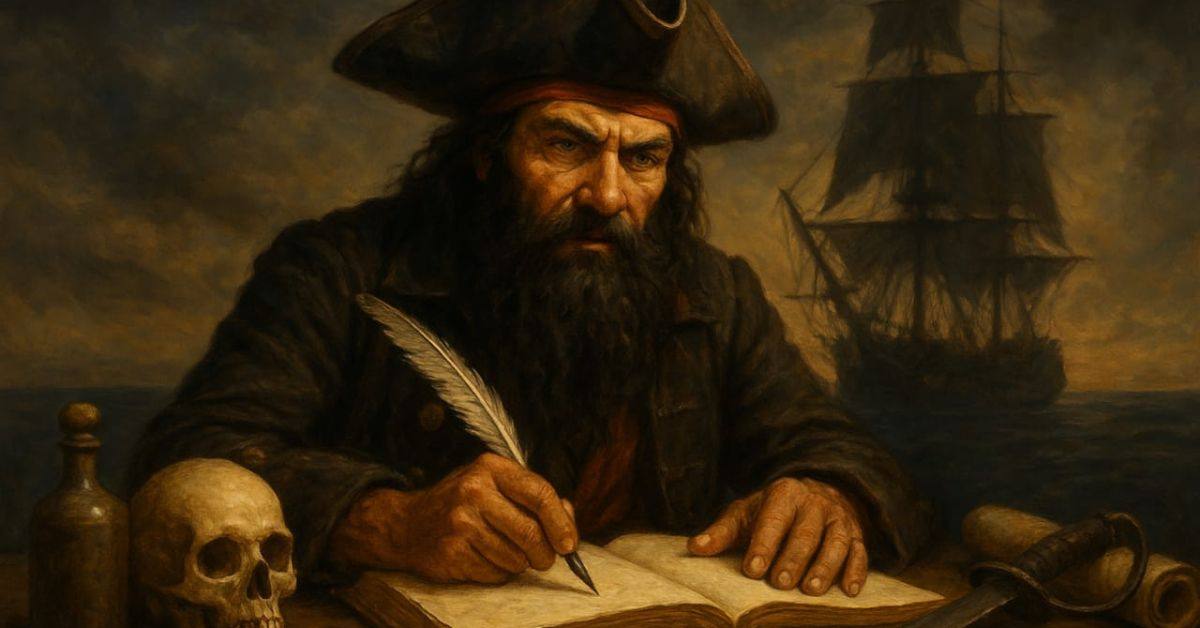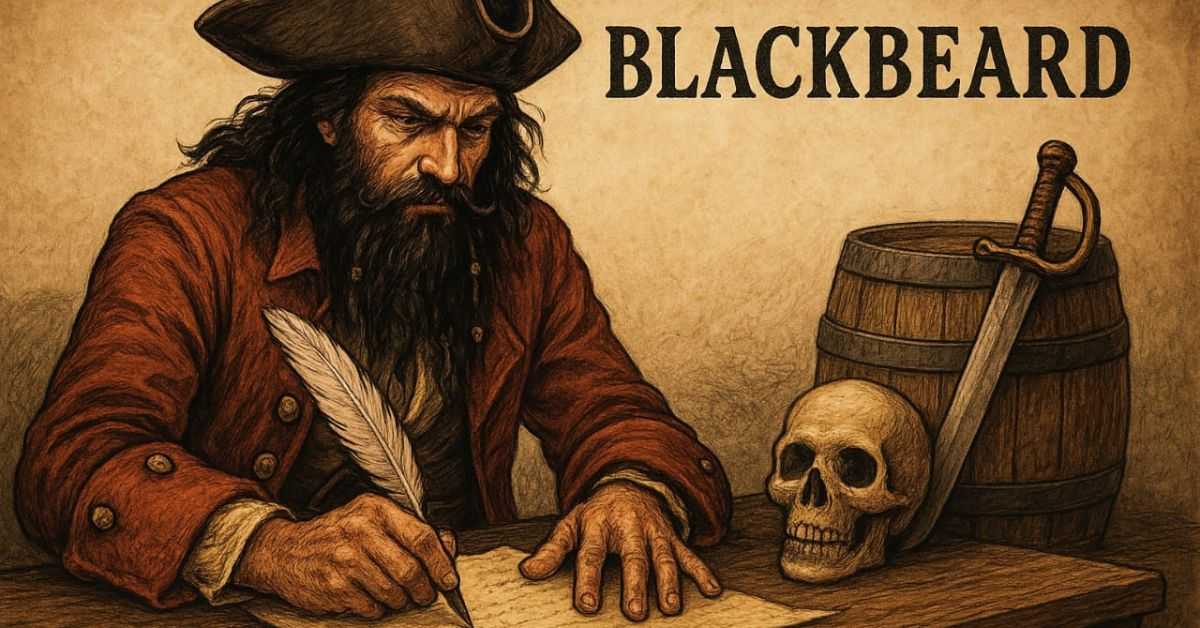Introduction
Few figures loom as large in maritime lore as Blackbeard, the infamous pirate who haunted the Atlantic in the early 1700s. But beneath the surface of canon balls and cutlasses lies a lesser-known mystery: Blackbeard writing. While historical accounts of his battles and brutality abound, surprisingly little is known about his written legacy. Did he write journals, leave coded messages, or influence storytelling traditions? In a digital age obsessed with content, tracing the origins of legendary figures—even pirates—offers powerful insights into the impact of myth, history, and storytelling on modern narratives.
This article dives deep into the known history, mythology, and scholarly exploration of what “Blackbeard writing” really means. Was it literal writing in logs? Or symbolic writing in the tales that came after him? Let’s unravel this windswept tale through the lens of 21st-century analysis.
The Real Blackbeard: Who Was Edward Teach?

To understand the foundation of Blackbeard writing, it’s essential to explore who he truly was. Born Edward Teach (sometimes spelled Thatch), Blackbeard made his mark during the Golden Age of Piracy—specifically around 1716 to 1718.
Highlights
- Blackbeard captained the Queen Anne’s Revenge.
- He was known more for psychological warfare than outright violence.
- His physical appearance—long black beard, slow-burning fuses in his hat—was crafted to incite fear.
Most official letters and colonial records refer to Blackbeard indirectly. He left little or no personal writings that survive today, deepening the mystery about his intellectual or literary pursuits—if any.
Discover the secrets of Blackbeard writing and start sharing your own pirate tales on the Start Nixcoders.org Blog today!
Did Blackbeard Keep Logs or Write Letters?
One of the biggest questions surrounding Blackbeard writing is whether the pirate himself recorded his own deeds. Records from the North Carolina Department of Cultural Resources and maritime archeological research have not revealed personal journals or letters.
Key findings
| Source Type | Evidence Found | Remarks |
| Ship logs | No known Blackbeard logs | Possibly destroyed or never kept |
| Colonial letters | Mentioned in 1718 dispatch | Written about him, not by him |
| Pirate manifestos | Mostly apocryphal | Attributed posthumously |
Given the traditions of secret-keeping and oral storytelling among pirate crews, it’s plausible that Blackbeard preferred verbal communication or limited writing to avoid incrimination.
Pirate Code and Communication: Decoding the Language of the Seas
While there’s no known “Blackbeard manuscript,” understanding how pirates communicated provides valuable context. Pirates often used symbolic flags, encoded messages, and agreed-upon codes to signal intentions or organize crew.
Common pirate communication strategies
- The Jolly Roger: A flag used as psychological warfare.
- Letters of Marque: Authorized piracy, issued by governments.
- Articles of Agreement: Pirate “contracts” with rules, often memorized or marked with Xs.
Pirate language was rich with metaphor, slang, and hidden meanings—echoes of which find their way into fictionalized Blackbeard writing in modern books and films.
The Evolution of Pirate Lore in Colonial Literature
After Blackbeard’s death in 1718, his legend only grew. Writers of the 18th and 19th centuries began embellishing tales to sell books and entertain readers.
Early depictions of Blackbeard in print
- “A General History of the Pyrates” (1724) by Captain Charles Johnson: The most influential account, though many details are fictionalized.
- Penny dreadfuls and sea stories in Victorian England: Painted pirates as romantic anti-heroes.
- Newspapers of the 18th century: Helped frame him as a menace to order.
In these sources, Blackbeard writing became synonymous with pirate tales—sometimes ghostwritten by journalists hungry for readership.
Storytelling and Symbolism: Blackbeard’s Influence on Modern Fiction
In the 20th and 21st centuries, Blackbeard’s mystique evolved. From Robert Louis Stevenson’s Treasure Island to Pirates of the Caribbean, his spectral influence can be seen in how pirates are portrayed across genres.
How Blackbeard’s tale shaped narrative tropes
- The cursed pirate: Immortal, haunted, or undead figures are now common.
- The anti-hero: Dangerous yet charismatic captains.
- The map-maker trope: Pirates leaving riddles or journals; a fictional element with no proven historical basis.
This fictional form of Blackbeard writing is less about fact and more about metaphor and metaphorical storytelling.
Literary Myths vs Historical Evidence: A Scholarly Comparison
It becomes essential to separate embellished storytelling from academic truth. Here’s a side-by-side evaluation.
| Aspect | Literary Portrayal | Historical Record |
| Education | Educated and articulate | No formal record |
| Journal-keeper | Wrote daily reflections | No logs or journals found |
| Multilingual pirate | Fluent in several languages | Highly unlikely |
| Romantic intrigue | Lover in every port | No evidence |
These differences reveal a widening gap between myth and history, especially when it comes to written materials falsely attributed to Blackbeard.
The Role of Blackbeard in Maritime Studies Today
In modern academic circles, Blackbeard serves as more than a cautionary tale. He is a subject of linguistic, anthropological, and psychological study.
Areas of academic research
- Cultural piracy: How pirates challenged power structures.
- Symbolic language: Analysis of coded flag systems.
- Folklore transmission: How myths are “written” through storytelling.
By examining what Blackbeard writing might have looked like—coded messages, oral contracts, or symbolic imagery—scholars contribute to reinterpreting his legacy beyond swashbuckling.
Blackbeard’s Image in Digital Storytelling and Pop Culture
From Netflix documentaries to YouTube educational videos, Blackbeard has seen a digital renaissance. Storytelling formats have shifted, but the appetite for pirate lore endures.
2025 Streaming Trends
- Interactive storytelling apps now feature pirate avatars influenced by Blackbeard.
- Educational VR in schools includes modules on pirate history.
- AI-writers have even attempted to “generate” what Blackbeard might have written.
This merging of fiction and algorithm shows just how far Blackbeard writing has traveled from scrawled parchment to pixels.
Insights from Archeology: Shipwrecks and Script
The Queen Anne’s Revenge, Blackbeard’s ship, was discovered in the 1990s near North Carolina. Since then, over 300,000 artifacts have been recovered, offering further clues.
Key Findings
- Navigational tools, but no books or scrolls.
- Oyster shells used to mix ink—hinting at possible writing activities.
- Lead shot, often marked, which may have doubled as coded warning.
While written works haven’t surfaced, these archaeological clues may point to the logistics and daily conditions that could explain why so little was recorded.
Why Blackbeard Writing Still Captivates Us in 2025
In the end, the allure of Blackbeard writing lies in its absence. What’s missing—journals, manifestos, letters—has inspired writers, scholars, and creatives to fill in the gaps.
This fascination speaks to deeper human instincts
- The desire to understand rebel thinkers.
- The romance of the sea as boundless freedom.
- The power of storytelling over fact.
In today’s content-driven world, where every thought is documented, the mystery of a man who left little behind in his own words is as magnetizing as the stories told about him.
Visual Supplement
Table 1: Known Primary Sources Related to Blackbeard
| Source Name | Content Description | Year |
| Governor Spotswood’s Letters | Colonial military reports | 1718 |
| Trial Records of Craven County | Mention of captured pirates | 1719 |
| Charles Johnson’s Pirate History | Early pirate myths and profiles | 1724 |
Frequently asked questions (FAqs)
Did Blackbeard write any books or letters?
There’s no surviving evidence of any personal writings.
Are there real pirate journals from the 1700s?
Yes, but none directly linked to Blackbeard himself.
Was Blackbeard literate?
Likely, though not definitively proven.
What’s the most famous fictional writing attributed to Blackbeard?
Captain Johnson’s 1724 book blends fact and fiction about him.
Where can I learn more about pirate literature?
University maritime programs and museum archives offer detailed research.Sneed Net Worth 2025
Conclusion
Exploring the legacy of Blackbeard writing isn’t just about the ink on old parchment—it’s about understanding how history becomes storytelling, how myth replaces facts, and how legends endure. While no definitive writing from Blackbeard survives, his narrative has been penned and re-penned by generations seeking to tap into his turbulent tale.
The digital era offers new opportunities to rediscover and reinterpret figures like Blackbeard—not just as pirates, but as personas reshaped by culture. Whether you’re a historian, writer, student, or casual reader, his story invites you to dig deeper.
Ready to explore more pirate myths and maritime mysteries? Subscribe to our historical deep dive newsletter and never miss an update!
